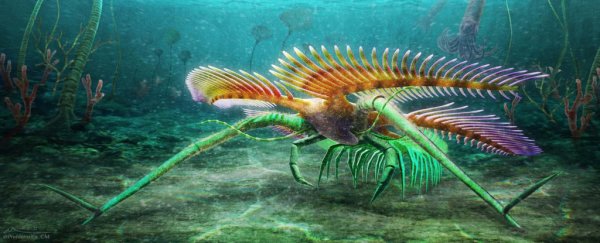Paleontologists recently announced the discovery of an "exceptionally well preserved" ancient animal near the eastern shore of Lake Simcoe in southern Ontario, Canada, in a stone quarry that is such a hotbed for marine fossils that scientists have dubbed the area "Paleo Pompeii."
Named Tomlinsonus dimitrii, the species represented by the specimen is part of an extinct group of arthropods known as marrellomorphs that lived approximately 450 million years ago, during the Ordovician period, the research team reported in a new study.
Other echinoderm fossils that are abundant in the area typically contain mineralized body parts that are more likely to be preserved over time, but this species is entirely soft-bodied, making the discovery all the more startling.
"We didn't expect to find a soft-bodied species at this site," said lead study author Joseph Moysiuk, a doctoral candidate in ecology and evolutionary biology at the University of Toronto and a researcher at Toronto's Royal Ontario Museum (ROM).
"When we think of fossils, we typically think of things like dinosaur bones and shells. However, soft-tissue preservation is very rare, and there are only a few sites around the world where soft-bodied organisms have been found," Moysiuk told Live Science.
Measuring 2 inches (6 centimeters) – just shy of an index finger's length and able to fit in the palm of a hand – the specimen features an ornate head shield that contains two curved horns covered in feather-like spines. The animal's segmented body resembles that of other arthropods, such as insects and spiders, and contains multiple sets of segmented limbs – including one very unusual pair.
"Underneath the head, there is this amazing pair of limbs that are extremely long and have foot-like projections at the terminal ends, which we think it most likely used to stilt its way across the seafloor," Moysiuk said. "It also appears to be blind, since it doesn't have any eyes at all."
Related: Photos: Trove of marine fossils discovered in Morocco
Researchers discovered the bizarre arthropod last summer during a formal excavation of an active quarry owned by the Tomlinson Group, an infrastructure service company based in eastern Canada. (Paleontologists named the species Tomlinsonus dimitrii as a nod to the Tomlinson Group for letting them excavate the site.)
Prior to this dig, which was led by George Kampouris, the paper's co-author and an independent paleontological technician who has been investigating the quarry's fossil beds since 2014, marrellomorphs were predominately found at older fossil sites, like the Cambrian Burgess Shale in the Canadian Rockies of British Columbia.
 The Tomlinsonus dimitrii fossil (left) and a line drawing of the specimen. (ROM)
The Tomlinsonus dimitrii fossil (left) and a line drawing of the specimen. (ROM)
According to paleontologists, the newly described specimen resembles another species of extinct soft-bodied arthropod called Marrella splendens, found at the Burgess Shale.
Similar to the Burgess Shale, the Lake Simcoe quarry was once submerged in water and was part of a shallow tropical marine sea that covered much of what is now modern-day Canada. Over millions of years, the seafloor became blanketed in sediment caused by storms.
"What we're seeing is the rapid burial of these organisms that were living on this flat, shallow ocean bottom and were repeatedly smothered by large undersea mudflows coming from storm events," Moysiuk said.
"You can imagine hurricanes hitting this shallow shelf area and burying the whole community of organisms, which is why we nicknamed the site 'Paleo Pompeii.' These organisms were entombed exactly where they were living, and what we're seeing is them frozen in time."
Moysiuk and his fellow researchers hope that this discovery will help "close the gap" in the fossil record for this group of arthropods, they wrote in the study.
The Tomlinsonus dimitrii specimen is now in ROM's collection and is currently on display in the Willner Madge Gallery as a part of the museum's "Dawn of Life" exhibit.
The findings were published March 24 in the Journal of Paleontology.
Related content:
Wipe out: History's most mysterious extinctions
Image gallery: 25 amazing ancient beasts
Photos: Ancient marine critter had 50 legs, 2 large claws
This article was originally published by Live Science. Read the original article here.
